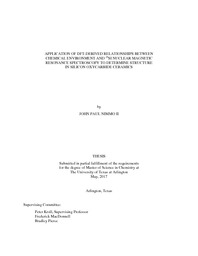
ATTENTION: The works hosted here are being migrated to a new repository that will consolidate resources, improve discoverability, and better show UTA's research impact on the global community. We will update authors as the migration progresses. Please see MavMatrix for more information.
Show simple item record
| dc.contributor.advisor | Kroll, Peter | |
| dc.creator | Nimmo, John Paul | |
| dc.date.accessioned | 2017-07-03T14:25:04Z | |
| dc.date.available | 2017-07-03T14:25:04Z | |
| dc.date.created | 2017-05 | |
| dc.date.issued | 2017-05-15 | |
| dc.date.submitted | May 2017 | |
| dc.identifier.uri | http://hdl.handle.net/10106/26773 | |
| dc.description.abstract | Silicon oxycarbide (SiCO) is an amorphous ceramic material widely used in industrial applications, for its useful electronic and biologically-compatible properties.1-3 SiCO is resistant to crystallization, remaining amorphous even above temperatures at which amorphous SiO2 would crystallize. Though silica (SiO2¬) and silicon carbide (SiC) are almost immiscible, it is useful to consider the material as a phase composition of these along with carbon, according to the formula below. The first two terms in braces can be considered as being the “SiCO glass” into which a third term representing excess or “free” carbon is incorporated as graphite-like nano-flakes and bands.
SiC_x O_y={y/2 SiO_2+(1-y/2)SiC}+(x+y/2-1)C.
Since these components are not able to be mixed, SiCO is typically made using a pyrolytic conversion from molecular or polymeric precursors. 4-6 This process is often monitored using 29Si solid-state nuclear magnetic resonance spectroscopy (SS-NMR, or simply NMR)7, because the changes in chemical bonding are observable through changes in the NMR signal. Clearly defined peaks can be seen for each type of {Si}CxO4-x tetrahedra present in the material. Differences in the chemical bonding environment affect the shielding of the nucleus, changing where the resulting signal appears in the spectrum.8 The area under these peaks can be integrated and used as a measure of the relative population of each chemical bonding environment. As the process of pyrolysis progresses the bonding environment around Si changes and so the shapes and ratios of these peaks shift accordingly.9
The precise mechanism of the interface between the free carbon and the host glass remains a topic of debate regarding SiCO. Though plausible models have been proposed in literature, supported by different infrared and X-ray spectroscopic data,10,11 none provide direct evidence regarding the nature of any chemical bonding or interaction between free carbon and silicon in the bulk glass. Recently, computational modeling has shown that there is a large energetic penalty for a bonding interaction between graphitic carbon and glassy SiCO.12 There has, however been no direct investigation to search for the nature of this interface.
Computer modeling of both structure and spectroscopy has proven to be an invaluable tool in the examination of materials and their properties.13-16 Hundreds of chemical systems can be constructed, analyzed, and compared to experimental results, allowing the exploration of environments and effects which might be difficult to access experimentally.17-21 For this work, models were generated using a modified Wooten-Winer-Weaire22 (WWW) method to provide a multitude of chemical environments to investigate. The use of density functional theory (DFT) along with the gauge-including projector augmented wave (GIPAW) method23 facilitates the calculation of NMR signals and parameters for the models. A small piece of custom software is used to extract precise structural information such as angles and distances between atoms from each model as well as the corresponding computed NMR chemical shift for each silicon atom.
Structural-chemical relationships in SiCO ceramics are investigated using these methods in an attempt to increase the amount of information that it is possible to extract from an experimental NMR spectrum. Nearby structural features within the model structures – the Si—O—Si tetrahedral bonding angles around every silicon atom are correlated with the computed NMR chemical shift for that atom. This gives a linear function relating the average Si—O—Si bonding angle around a central Si atom, for each SiCxO4-x center (for 0 ≤ x ≤ 3). These angular correlation functions can in turn be applied to experimental NMR data to extract information about the distribution of angles within the material. Furthermore, appropriate models are analyzed in order to discern the differences between silicon bound to 3-connected (sp2 bonded) carbon bound to silicon versus 4-connected (sp3-bonded) carbon bound to silicon. Models which compared systems with free carbon chemically bound to the glass with models where the free carbon is completely disconnected are also included. Therefore experimental spectra can be analyzed to extract the distribution of Si—O—Si angles and to search for evidence of bonding between graphitic carbon and Si atoms in the host glass. | |
| dc.format.mimetype | application/pdf | |
| dc.language.iso | en_US | |
| dc.subject | Chemistry | |
| dc.subject | Solid-state | |
| dc.subject | DFT | |
| dc.subject | SiCO | |
| dc.subject | Silicon oxycarbide | |
| dc.title | APPLICATION OF DFT-DERIVED RELATIONSHIPS BETWEEN CHEMICAL ENVIRONMENT AND ²⁹Si NUCLEAR MAGNETIC RESONANCE SPECTROSCOPY TO DETERMINE STRUCTURE IN SILICON OXYCARBIDE CERAMICS | |
| dc.type | Thesis | |
| dc.degree.department | Chemistry and Biochemistry | |
| dc.degree.name | Master of Science in Chemistry | |
| dc.date.updated | 2017-07-03T14:25:35Z | |
| thesis.degree.department | Chemistry and Biochemistry | |
| thesis.degree.grantor | The University of Texas at Arlington | |
| thesis.degree.level | Masters | |
| thesis.degree.name | Master of Science in Chemistry | |
| dc.type.material | text | |
| dc.creator.orcid | 0000-0001-6167-3514 | |
Files in this item
- Name:
- NIMMO-THESIS-2017.pdf
- Size:
- 2.420Mb
- Format:
- PDF
This item appears in the following Collection(s)
Show simple item record


